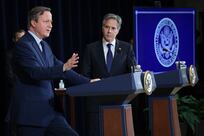Around the world for the past two years, the big question has been whether the new American profile is simply a Donald Trump phenomenon or whether this is a more permanent orientation for the US both at home and abroad.
After last week’s midterms, that question still cannot be confidently answered because an extraordinary number of tectonic plates in American politics are shifting concurrently.
Anyone hoping for a total repudiation of Mr Trump despite the booming US economy might have been disappointed by the outcome of the elections but compared to two years ago, it’s still good news.
The midterms delivered a mixed result, leaving, as I predicted, both sides with reasonable grounds for feeling simultaneously vindicated and vulnerable.
In The National shortly after the 2016 election, I noted that Mr Trump's surprising victory opened the possibility of a total realignment of the American political landscape.
In that scenario, working-class and union constituencies around the country, plus domestic businesses and industries, would shift to the Republican Party, champions of Fortress America.
This would be coupled with an increasing shift of US-based multinational industries, as well as more internationalist, cosmopolitan constituencies, to the Democrats, guardians of US leadership and global order.
US politics would then no longer be divided along its traditional left-right axis but rather, based on open-versus-closed national social and economic attitudes.
Mr Trump hasn’t accomplished that yet but he’s continuing to make progress. White rural, exurban and working-class voters continued to turn out for him in massive numbers, preserving and expanding the Republican control of the Senate.
This is obviously a profound frustration for Democrats. However, the growing support of urban and suburban middle- and upper-middle-class, college-educated Americans of all ethnicities for Democrats underscored a slowly unfolding but substantial House victory.
Most notable were striking Democratic gains in midwestern and increasingly “blue” mountain states, despite disappointing defeats in Missouri, Indiana and North Dakota.
Democrats also boasted unusually strong performances in southern states such as Georgia, Florida and Texas, with some key races still undecided.
That all suggests that Democrats are consolidating strong control of the national popular vote, as indicated in their greatly disproportionate share of overall votes cast for those now serving in the Senate, despite continuing to lose ground there because of the federal electoral structure.
As the brilliant commentator Michael Tomasky notes, Democrats certainly need a rural strategy to become competitive again in many “red” areas, and a new economic narrative.
But it seems clear that Republicans face a grim future in the long run as a rural, white, ethno-national party with little appeal in the urban and suburban areas where most Americans increasingly live.
The bottom line is that Democrats have significantly cracked Republican control of the whole of government and expanded their popular appeal with the American majority.
Mr Trump, meanwhile, has almost consolidated his total control of the Republican Party. But the Democratic victory in the House of Representatives gives a new lease of life, however small, to traditional, conservative Republican opposition to Mr Trump.
Had Republicans held the House of Representatives, the US president would have been guaranteed no primary challenger, no matter what happened to the economy. Had Republicans lost the Senate, that challenge might have been formidable.
_______________
Read more on midterm elections:
[ Trump is now in a position to consolidate his legacy on the domestic and foreign policy front ]
[ US president hails midterms 'a big victory' ]
[ What does outcome mean for the 2020 presidential election? ]
[ US Congress welcomes trailblazers as record number of women and minorities elected ]
[ Midterm results are the first steps to curtailing Trump's power ]
_______________
As it stands, some Republican opposition to Mr Trump will continue and there will be alternatives waiting in the wings should some crisis or scandal emerge in the next two years.
Many congressional Republicans will now worry that Mr Trump will abandon them and seek to make common cause with House Democrats on populist measures such as infrastructure, spending and healthcare.
That’s possible – but Mr Trump’s past form suggests he would prefer to fight on racial and migration issues rather than switch to the broader realignment strategy Republicans will need for their long-term viability.
All this uncertainty leaves the rest of the world, friends and foes alike, still wondering whether “America First” is the new face of the US or simply a Trump aberration.
It’s not even clear if “America First” is a new kind of US internationalism or neo-isolationism, as Mr Trump has oscillated unpredictably between the two.
The cyclical pattern of American politics in a post-Cold War era suggested Republicans were due for a comprehensive victory in 2016, which they got. Then it hinted that Democrats would retake the House now, which they have.
It also implies that Mr Trump is now better positioned to be re-elected in 2020, barring a major scandal or meltdown, by blaming everything on House Democrats.
Yet the broader context is becoming consolidated. And there’s good news and bad news for both sides.
The good news for Republicans is that the federal American system, established at the end of the 18th century for entirely different reasons, now gives their voters disproportionate sway in much of the government and unfairly favours them.
The good news for Democrats is they have the solid and growing support of most of the American people.
And the only rational conclusion for US allies is, you had better be on good terms with both Democrats and Republicans – and not become a partisan football.
Hussein Ibish is a senior resident scholar at the Arab Gulf States Institute in Washington




